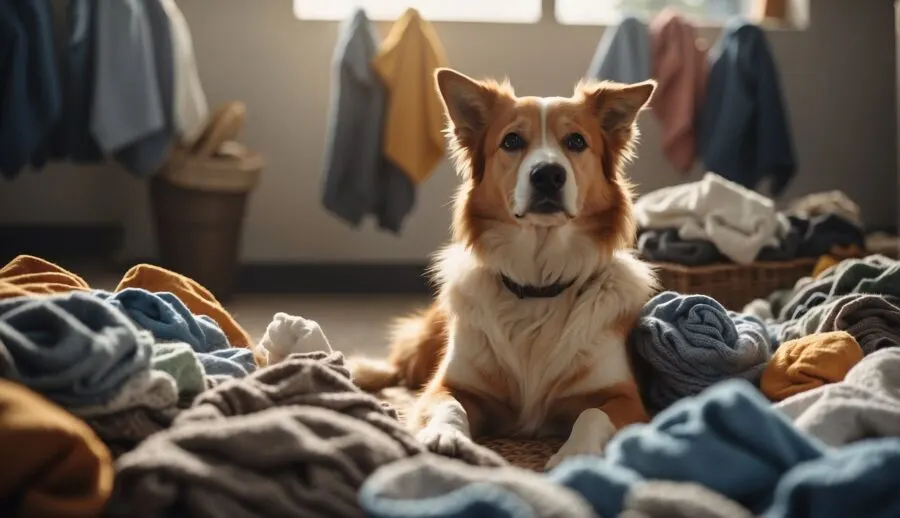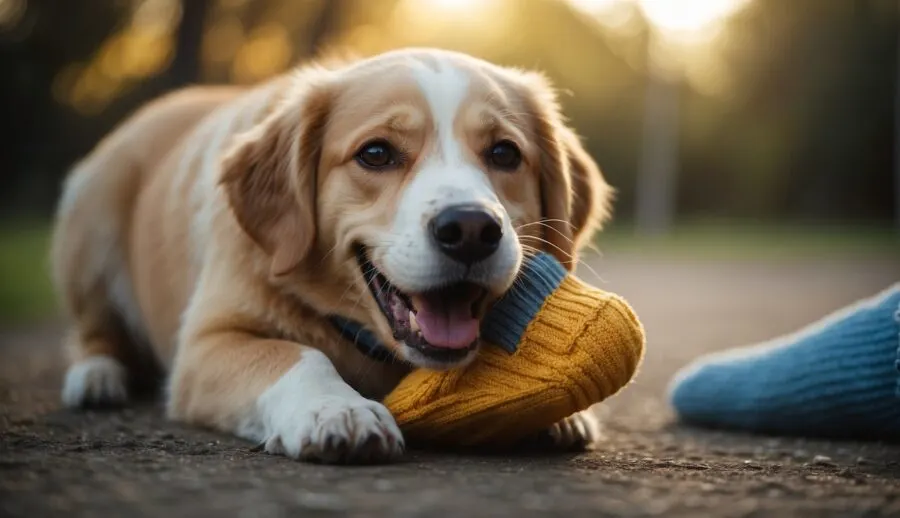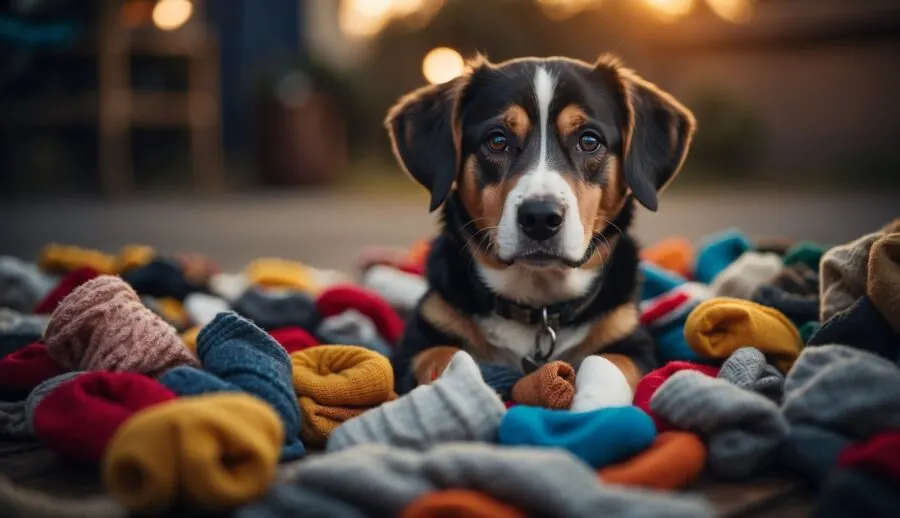Dogs have a unique attraction to socks, often seen carrying, chewing, or hoarding them as treasured possessions. While this behavior might seem peculiar, it can be explained by understanding a dog’s senses and their natural inclinations. Socks carry the scent of their owners, which to a dog, acts as a comforting reminder of their human companion. The familiar smell provides a sense of security and can help alleviate feelings of loneliness or anxiety when their owner is away.

Beyond the scent, socks are typically soft and chewable, which appeals to a dog’s playful nature and desire to bite or chew as part of exploring their environment. They often see socks as toys, especially if engaging in a game of tug-of-war with their owner.
Additionally, the behavior could be a sign of attention seeking, when a dog learns that snatching socks is a surefire way to engage their owner in interaction. While this behavior is mostly harmless, there are potential health risks associated with ingesting fabric!
Key Takeaways
- Dogs are drawn to socks due to their owner’s scent which provides comfort.
- Socks appeal to a dog’s desire to chew and play, serving as makeshift toys.
- It’s important to supervise dogs with socks to avoid ingestion and health issues.
Why Do Dogs Like Socks So Much?

Your furry friend’s sock-snatching habit might be puzzling, but several common reasons explain why dogs are especially attracted to your socks.
Smell and Taste Preferences
Your socks carry your personal scent, which can be quite appealing to your dog due to their powerful sense of smell.
Dirty socks are especially potent with the smell of sweat and your unique scent, making them irresistible to your best friend! The taste, tinged with saltiness from sweat, might also be intriguing for your dog.
Socks as Substitutes for Chew Toys
Dogs often need something to chew on, and socks can provide a suitable texture similar to chew toys. Soft and pliable, they can be a satisfying outlet for your dog’s natural chewing instinct and help keep their jaws strong.
The Thrill of the Chase and Playtime
The act of stealing a sock might be part of a fun game for your dog. It involves the thrill of the chase, especially if you run after them to retrieve it. This playful behavior is a form of exercise and mental stimulation for your dog, making playtime an exciting adventure for them.
Attachment and Comfort Seeking
Socks can be a source of comfort and familiarity for your dog, serving as a security blanket of sorts. Your pet may feel close to you by snuggling with your socks, and the familiar scent can provide a sense of security and attachment, especially when you’re not around.
Understanding Canine Behavior
Your dog’s fascination with socks can be puzzling, but it’s a behavior that makes more sense when you consider scent’s importance, their innate curiosity, the normalcy of chewing, and psychological needs that arise from feelings like boredom and anxiety.
The Role of Scent in Dog Behavior
Dogs have an acute sense of smell. The scent left on socks by humans is rich with pheromones and tells a tale that your dog finds incredibly engaging. To your dog, a sock is like a scented postcard from you, delivering familiarity and comfort through your unique odor.
Canine Curiosity and Exploratory Behaviors
Curiosity is a driving force in dog behavior. Dogs explore their world through their senses, and a sock presents a novel item with interesting textures. Investigating a sock can satisfy a dog’s exploratory impulses, whereas your reaction to them taking a sock can further encourage their behavior.
Significance of Chewing for Dogs
Chewing is a natural behavior for dogs, especially for puppies that are teething. It helps in managing discomfort, keeping their jaws strong, and their teeth clean. For adult dogs, a sock might resemble a soft chew toy, providing a similar tactile experience.
Psychological Factors: Boredom and Anxiety
Like humans, dogs can experience emotions that affect their behavior. Boredom or separation anxiety can lead a dog to seek out ways to alleviate their stress. A sock carries your scent which can have a calming effect on your dog, acting as a stress-reliever in your absence.
Potential Problems from Sock Obsession

While your dog’s fascination with socks might seem cute, it’s important to be aware of several potential issues related to this behavior. Ingesting socks can lead to serious health problems, and the obsession might also signify underlying behavioral issues.
Dangers of Eating Socks
When your dog eats a sock, they risk intestinal blockage, a condition that can be life-threatening and requires immediate veterinary attention. Symptoms of blockage include vomiting, lethargy, and a lack of appetite. This condition is particularly dangerous since the fabric of socks does not break down in the digestive system.
Behavioral Issues and Destructive Behavior
Sock stealing could be a sign of pica—a condition where dogs crave non-food items. This behavior might also indicate boredom or a lack of mental stimulation, leading to destructive behavior. Consistent sock chewing doesn’t just ruin your socks; it can reflect unmet physiological or psychological needs in your dog.
Preventing and Addressing Sock Stealing
Prevention is key to managing your dog’s sock obsession. You can train commands like “leave it” or “drop it” to control these behaviors. Using positive reinforcement during training can help your dog learn that ignoring or releasing socks leads to better rewards. Keep socks out of reach to reduce temptation and provide plenty of appropriate chew toys to prevent the stealing and chewing of socks.
By understanding these potential problems, you can take proactive steps to keep your dog safe and healthy while also addressing any underlying issues that their sock obsession might indicate.
Health and Safety Considerations
When your dog shows an interest in socks, it’s important to consider their health and safety. It’s essential to be aware of the potential risks and know when to seek professional advice to ensure your pet remains happy and healthy.
Consulting With a Veterinarian
If you notice your dog is frequently taking socks and this behavior seems obsessive or compulsive, it’s wise to consult your veterinarian. They can assess whether this habit is due to anxiety, dietary deficiencies, or simply playful behavior. If your dog exhibits signs of lethargy or changes in appetite in conjunction with their sock fetish, a vet visit is especially important.
What To Do if Your Dog Eats a Sock
Socks, though harmless when worn, can be risky as a chew toy:
- Choking hazard: Socks can easily become lodged in a dog’s throat.
- Gastrointestinal obstruction: Ingested socks can cause blockages requiring surgical removal.
- Toxic substances: Used socks might contain harmful pathogens or chemicals.
Watch for signs of distress, such as difficulty breathing, vomiting, or a distended belly, which require immediate veterinary attention.
Providing a Safe Environment
To keep your dog safe:
- Offer plenty of physical exercise and mental stimulation to divert their attention from socks.
- Ensure your socks are kept securely in drawers or laundry baskets.
- Replace socks with safe, vet-approved chew toys that satisfy your dog’s need to gnaw.
- Observe your dog’s interaction with their toys and inspect toys regularly for signs of wear and damage.
By taking these precautions, you can provide a secure and safe environment for your dog.
When your furry friend snatches a sock, it’s often a sign they find comfort in something that carries your scent. It’s akin to a security blanket, providing a familiar aroma that can be soothing. Resource-guarding, a behavior where dogs protect their valued finds, might also come into play with your socks, as they can be seen as prized possessions.
Remember, it’s essential to provide suitable alternatives to discourage your dog from turning into a sock thief. Socks aren’t the safest toys and can pose a choking hazard or lead to digestive blockages if swallowed.
- Healthy Distractions:
- Offer chew toys or interactive puzzles to keep them engaged.
- Spend quality playtime to help mitigate attention-seeking sock swipes.
Consider gentle training techniques if your dog exhibits resource-guarding. It’s crucial to ensure they don’t feel fear or anxiety about having their ‘treasures’ taken away, which may exacerbate the behavior. Positive reinforcement can encourage them to drop the sock in exchange for a treat or favorite toy.
Understanding Your Dog’s Behavior:
- Comfort: Is it a scent thing, or do they just need a soft toy to cuddle?
- Sock Thief: Could they be seeking attention or displaying playful behavior?
- Fear: Make sure they feel secure without needing to resort to guarding socks.
By providing comfort through your presence and appropriate toys, you can reduce the chances of your socks going missing while supporting your dog’s need for safety and entertainment.
- Review: Jimmy BX7 Pro Anti-Mite Vacuum Cleaner - December 16, 2024
- 🎉 GIVEAWAY: Lord of the Pets Portrait of Your Dog! - November 26, 2024
- Review: Lord of the Pets Portraits - November 17, 2024
